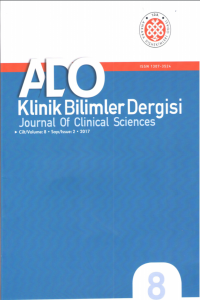Kırıkkale İline Bağlı İlçe Merkezlerinde Yaflayan Okul Çocuklarında 6 Farklı Materyalin Yüzey Örtücü Olarak Değerlendirilmesi: Ön Rapor
çürük, koruyucu tedaviuygulaması, fissür örtücü
Evaluation of six different sealant materials in school children living in Kırıkkale districts: Preliminary Report
caries, prevention treatments, fissuresealant,
___
- Simon C, Tesfaye F, Berhane Y. Assessment of the oral health status of school children in Addis Ababa. Ethiop Med J. 41; 245-56, 2003.
- Künzel W. Trends in caries experience of 12-year-old chil- dren in east European countries. Int J Pediatr Dent. 6;221–6,1996.
- Petersen PE, Danila I, Dalean FA, Grivu O, Ionita G, Pop M, et al. Oral health status among schoolchildren in Romania1992. Community Dent Oral Epidemiol. 22;90–3. 1994.
- Ağız ve Difl Sağlığı Hizmetlerinin Finansmanı, Örgütlenmesi, Sunumu Kurultayı. Türk Diflhekimleri Birliği Yayınları. Eğitim dizisi: 10, 2002.
- Gökalp S, Doğan BG. Türkiye Ağız-Difl Sağlığı profili 2004. Hacettepe Üniversitesi, Ocak 2006; s: 56-9,114-5.
- Arrow P. Oral hygiene in the control of occlusal caries. Community Dent Oral Epidemiol. 26; 324–30,1998.
- Holmen L, Meja`re I, Malmgren B, Thylstrup A. The effect of regular professional plaque removal on dental caries in vivo. Caries Res. 22;250–6,1988.
- Carvalho J, Thylstrup A, Ekstrand K. Results after 3 years of non-operative occlusal caries treatment of erupting perma- nent first molars. Community Dent Oral Epidemiol. 20; 187–92, 1992.
- Dülgergil ÇT, “Türkiye’deki diflhekimliği uygulamalarında yeni bir bölüme mi ihtiyacımız var? Yetersiz teknik ve ekonomik flartlar için Kırsal Alan Diflhekimliği”, Diflhekimliği Dergisi. 57; 161-70,2004.
- Dülgergil ÇT, Soyman M, Civelek A, Ercan E, Ercan M: Güneydoğu Anadolu kırsalında yaflayan çocuklarda değiflik koruyucu uygulamaların değerlendirilmesi: 24 aylık saha çalıflması sonuçları. A. Ü. Difl Hek. Fak Derg. 16;26-32, 2006.
- Beiruti N, Frencken JE, van't Hof MA, Taifour D, van Palenstein Helderman WH. Caries-preventive effect of a one-time application of composite resin and glass ionomer sealants after 5 years. Caries Res. 40; 52-9, 2006.
- de Luca-Fraga LR, Pimenta, LAF: Clinical evaluation of glass- ionomer/resin based hybrid materials used as pit and fi ssure sealants. Quintessence Int 32; 463–68,2001.
- Locker D, Jokovic A, Kay EJ: Prevention. 8. The use of pit and fissure sealants in preventing caries in the permanent dentition of children. Br Dent J 195; 375–8,2003.
- Taifour D, Frencken JE, van 0t Hof MA, Beiruti N,Truin G-J. Caries-preventive effect of a one-time application of com- posite resin and glass ionomer sealants after 5 years. Community Dent Oral Epidemiol. 31;314-9, 2003.
- Mejàre I, Lingström P, Petersson LG, Holm A-K, Twetman S, Källestål C et al. Caries-preventive effect of fissure sealants: a 61;321–30,2003. Acta Odontol Scand.
- Messer LB, Calache H, Morgan MV. The retention of pit and fissure sealants placed in primary school children by Dental Health Services, Victoria. Aust Dent J. 42;233-9, 1997.
- Klein SP, Bohannan HM, Bell RM, Disney JA, Foch CB, Graves RC. The cost and effectiveness of school-based pre- ventive dental care. Am J Public Health 75;382–91,1985.
- Varenne B, Petersen PE, Ouattara S. Oral health status of children and adults in urban and rural areas of Burkina Faso, Africa. Int Dent J. 54; 83–9, 2004.
- Ayrancı Ü. Bir grup ilkokul öğrencisinde difl çürüğü saptama arafltirmasi. Sürekli Tıp Eğitim Dergisi.14;50-54,2005.
- Morphis TL, Toumba KJ. Retention of two fluoride pit-and-fis- sure sealants in comparison to a conventional sealant. Int J Paediatr Dent. 8;203-8,1998.
- Corona SA, Borsatto MC, Garcia L, Ramos RP, Palma-Dibb RG.Randomized, controlled trial comparing the retention of a flowable restorative system with a conventional resin sealant: one-year follow up. Int J Paediatr Dent. 15;44- 50,2005.
- Poulsen S, Laurberg L, Vaeth M, Jensen U, Haubek D. A field trial of resin-based and glass-ionomer fissure sealants: clin- ical and radiographic assessment of caries. Community Dent Oral Epidemiol. 34;36-40, 2006.
- Chadwick B. Flowable restorative systems has a higher retention rate than conventional resin sealant on primary teeth. Evid Based Dent. 6;89, 2005.
- Lekic PC, Deng D, Brothwell D. Clinical evaluation of sealants and preventive resin restorations in a group of envi- ronmentally homogeneous children. J Dent Child.73;15- 9,2006.
- ten Cate JM. Remineralization of caries lesions extending into dentin. J Dent Res. 80;1407-11, 2001.
- Moszner N, Klapdohr S. Nanotechnology for dental com- posites Int. J. of Nanotechnology. 1; 130-56, 2004.
- Morphis TL, Toumba KJ. Retention of two fluoride pit-and-fis- sure sealants in comparison to a conventional sealant. Int J Paediatr Dent. 8;203-8,1998.
- Yildiz E, Dorter C, Efes B, Koray F. A comparative study of two fissure sealants: a 2-year clinical follow-up. J Oral Rehabil. 31;979-84,2004.
- ISSN: 1307-3540
- Yayın Aralığı: Yılda 3 Sayı
- Başlangıç: 2006
- Yayıncı: Ankara Diş Hekimleri Odası
Karbon Dioksit Lazerin Ağız Dokularında Kullanımı
Diş Üniti Su Yolu ve Suyu Dental Tedavilerde Risk Oluşturur Mu?
Çocuklarda Dental İmplant Uygulamaları
Ortodontik Tedavide Alt Keser Çekimi
Ömür Polat ÖZSOY, Esen AYDOĞDU
Avulse Üst Daimi Keser Dişin Tedavisi: Multidisipliner Bir Yaklaşım
Kıvanç YAMANEL, Kamran GÜLŞAHI, Alper ÇALAR, Ömür POLAT
Yeni Bir Bakış Açısı: Kanıt-Destekli Dişhekimliği
Maksillofasiyal Protezlerin Yapımında Kullanılan Materyallerdeki Gelişmeler
Bilge Turhan BAL, Emre ÖZTÜRK, Seçil KARAKOCA
Ç Türksel DÜLGERGİL, Ertuğrul ERCAN, Işıl YILDIRIM, Meryem ERCAN, Murat ÖZTÜRK, Mehmet DALLI, Rojan ARCAK
Bifosfonat Kullanımına Bağlı Gelişen Mandibula ve Maksilla Nekrozları ve Dental Yaklaşım
Piezoelektrik Cerrahinin Temelleri: Oral ve Maksillofasiyal Cerrahide Kullanımı
